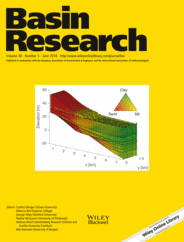
Full text loading...
Previous research demonstrates that large basins on the periphery of the northern edge of the Tibetan Plateau were partitioned during development of intrabasin mountain ranges. These topographic barriers segregated basins with respect to surface flow and atmospheric circulation, ponded sediments, and formed rain shadows. However, complex mixing between airmasses and nonsystematic isotope‐elevation lapse rates have hampered application of quantitative paleoaltimetry to determine the timing of development of critical topographic barriers. We address the timing and drivers for changes in surface connectivity and atmospheric circulation in the Linxia and Xunhua basins using a multidisciplinary approach incorporating detrital zircon geochronology, Monte Carlo inverse flexural modelling, and published stable isotope data. Disruption of surface flow between the two basins during exhumation of the Jishi Shan preceded development of topography sufficient to intercept moisture‐bearing airmasses. Detrital zircon data point to disruption of an eastward‐flowing axial fluvial network between 14.7 and 13.1 Ma, coincident with the onset of exhumation in the Jishi Shan. Flexural modelling suggests that by 13 Ma, the Jishi Shan had developed 0.3 ± 0.1 km of relief; sufficient to disrupt eastward‐flowing drainage networks but insufficient to intercept moisture‐bearing airmasses. Stable isotope data indicate that, although surface connections between the Xunhua and Linxia basins were broken, the two basins continued to be dominated by a common climate regime until 9.3 Ma. Subsequent reintegration of surface flow between the basins occurred between 9.3 and 7.6 Ma. Divergence in the stable isotope and depositional environment records between the two basins suggests that at 9.3 Ma the paleo‐Yellow River breached the growing Jishi Shan dam, and may have reintegrated surface flow between the two basins via erosion of the modern Yellow River gorge, which transects the Jishi Shan. The reintegration of the Xunhua and Linxia basins’ surface connection is confirmed by reintroduction of a Songpan‐Ganzi flysch sediment source by 7.6 Ma. Continued exhumation and uplift of the Jishi Shan developed 0.8 ± 0.2 km of relief by ca. 8 Ma capable of intercepting moisture‐bearing airmasses; isolating and increasing aridity in the Xunhua Basin while decreasing it in the Linxia Basin. Our findings point to protracted development of the modern ca. 1 km of relief in the Jishi Shan between 14 and ca. 4.5 Ma followed by attainment of a topographic equilibrium which persists into modern times.

Article metrics loading...

Full text loading...
References


Data & Media loading...
Supplements

